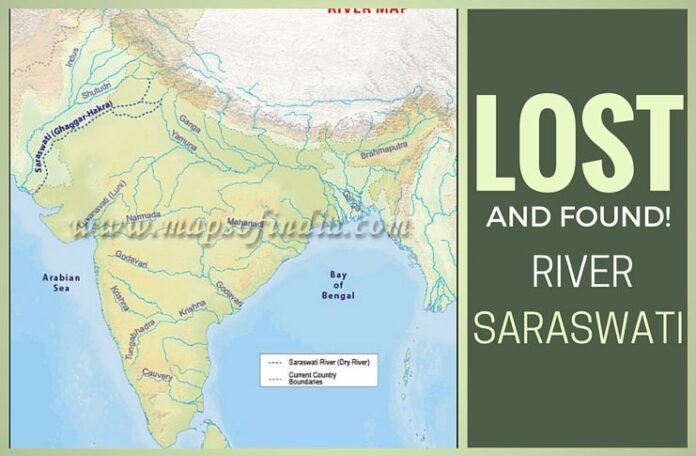
She has been worshiped for ages as the deity of knowledge and consort of Brahma. She is the giver of ‘vidya’ (education/knowledge) as well as the ruler of ‘arts’. However, in the Vedic Age, she was a living entity, a river in full spate nourishing the lands which form the present day North and West India. Yes, we are talking about the river Saraswati who has been mentioned at least 45 times in the Rig Veda.
In recent times the Haryana Government has commenced a project to unearth the lost river at a cost of close to rupees 50 crores. While there are sceptics who doubt the existence of such a river, the faithful are certain that what has been discovered is indeed the river that had been in full flow during the Vedic Age and has resurfaced after all these years.
Saraswati during the Vedic Age and later times:
Rivers have played, and continue to play, an important role in the progress of civilizations all over the world. Of the several rivers that flowed through the country several centuries ago, Saraswati enjoyed an exalted position. All rivers were personified as Devis and hymns were composed praising them. River Saraswati has been mentioned in all important Vedic as well as later Vedic scriptures such as the Rig Veda, Brahmanas and even Mahabharata. The Nadistuti (Hymn in praise of river) sukta (Rig Veda 10.75) identifies the major rivers of those times which include Ganga, Yamuna, Saraswati and Sutudri (Sutlej). Several verses in the Rig Veda are testimony to the fact that the river indeed originated in the Himalayas and flowed into the ocean namely the Arabian Sea. The later Vedic texts talk of the gradual disappearance of the river and the Mahabharata mentions the drying up of Saraswati as being lost in the desert. The scriptures also mention that even though the river dried up physically she continues to flow underground and meets the Ganga and Yamuna at the Triveni Sangam.
Recent findings:
Not much was known about how the river disappeared and there were even raging debates as to whether Saraswati actually existed as a physical river during the Rig Vedic times. In recent times several modern techniques such as satellite (paleo-channels have been confirmed by images captured by ISRO and NASA) and ground mapping, analysing paleo-seismic and paleo-climatic records etc. All these techniques have helped to successfully identify the Vedic Saraswati and trace her channel.
So what happened to a river flowing in full spate? It is not a matter of speculation that Himalayas are a seismic zone and prone to earthquakes. The Indian subcontinent keeps pushing into the Asian plate thereby causing the Himalayas to rise every year. Experts opine that a combination of climatic changes along with tectonic activities caused the river to first dwindle and then gradually disappear. A major earthquake is believed to have cut off the feeder rivers of Saraswati thereby reducing the quantum of water that flowed into the ocean. With the onset of arid climate, towards the end of Indus Valley Civilization, the river further lost her water sources and soon disappeared. It is believed that the river flowed during the times of Mahabharata and that Krishna might have escaped the wrath of King Jarasandha by fleeing from Mathura to Dwaraka by boats on the River Saraswati. Thus one of the names given to Krishna is Ranchod (Someone who flees from the battle).
It is interesting to note that several smaller streams, lying in the present state of Haryana and Rajasthan, have been named Saraswati. This could be the believers’ way of keeping the memories of the river alive. Another simpler explanation is that these smaller streams could be a part of what once formed a mighty river nourishing the land.
Revival project:
Amidst this background the Haryana Government launched the ambitious ‘Saraswati Revival Project’ on 21st April 2015 at Rolaheri village in Yamunanagar district of Haryana (River Saraswati Revival Project). This project aims to revive the Saraswati by using a combination of excavation, constructing check dams and diverting water from the Som River. The benefits are expected to be manifold including increase in religious tourism and water conservation among others.
No project is without its fair share of criticism and the skeptics are of the opinion that the government is simply trying to waste money on a ‘dead river’. Some also believe this is an attempt by the rightist government to give the issue a political and religious hue. Whether or not that is true is a matter of debate. I, for one, believe that if the project is going to bring in long term benefits then we need to give it a shot. Besides not everything is to be seen or interpreted with tinted glasses. Keeping an open mind is particularly important in issues which involve the sensitivities and sentiments of people at large.
While the political debate continues to rage, the river Saraswati continues to intrigue us. Till the time that she returns in full spate to nourish the lands of Haryana, Rajasthan and Gujarat and retrace her journey from the Himalayas to the Arabian Sea we can continue singing her paeans with this Rig Vedic hymn
अम्बितमे नदीतमे देवितमे सरस्वति।अप्रशस्ता इव स्मसि प्रशस्तिमम्ब नस्कृधि॥ऋ २।४१।१६॥
(Meaning: Oh Mother, the greatest of the mothers, rivers, and Devi, oh Saraswati, we are unfit, make us fit.)
- Revering our rivers: a story of revival - August 22, 2016
- The saga of the elephant headed God – Sripuranthan Ganesha - July 22, 2016
- Ghar Wapsi of Chola bronzes - June 20, 2016











Impressive article about The River Saraswati. Thanks
Really nice post about the overall development for job applicants especially people expecting govt jobs will like this site very much. Thanks a lot
Regards:
Sarkari Results
Very interesting and informative read.
My only comment is to do with the identification of Saraswati. I refer to Shri Michel Danino’s book where he clearly shows with proofs that Ghaggar-Hakra has been continuously identified with Saraswati for the last 150 years by British, French, Indian and other archaeologists, geologists – much before satellite mapping. Even the doyen of leftist historians, Romila Thapar and their ilk had no issues with the identification of Saraswati. There was never any doubt.
Till 1980’s.
In 1980’s satellite studies showed conclusively that the Saraswati had definitely dried up before 1900 BCE. And since Rig Veda refers to a fully flowing Saraswati, it must be much more older than that!
Now that was against the so-called “Aryan Invasion / Migration theory”, according to which Aryans had come to India not before 1700 BCE. The theory should have died its natural death then.
Instead, like typical Marxists, they started “expressing doubts” about the fact itself, the identification, which till then 100’s of scholars world-wide had never doubted. This was picked up by communist mouthspeaks like “The Hindu” etc, and has been repeated so many times for 30 years that the entire history has been white-washed.
Shri Michel Danino’s book is the best reference of the complete history of the re-discovery of Saraswati, and I would definitely recommend that book to get a clearer context of what is at stake here given what you have explained in details about the Revival Project.
Thanks for your comments and un-verified data points to an earthquake that happened in 2200 BCE that may have stopped the flow of the River Saraswati. Pl. await the follow-up article on this, coming in a few weeks.
well reserched article , river saraswati does xist and this belief is there in rajasthan too ,wher i lived for 1st 25 yrs , maybe advent of desert was the reason of dissapearance